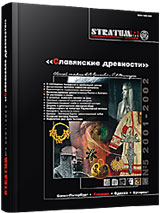Некоторые дискуссионные вопросы изучения волынцевских памятников междуречья Средней Десны и Средней Ворсклы
Some Questions for Discussion of Reaserch of Antiques of Volyntsevo Type between the Desna and the Vorskla
Author(s): Viktor V. PryimakSubject(s): History, Archaeology, Cultural history, Middle Ages, 6th to 12th Centuries
Published by: Издательский дом Stratum, Университет «Высшая антропологическая школа»
Summary/Abstract: According to the last materials, the problems for discussion are examined for research of antiques of Volyntsevo type, the main part of which is situate in pointed region (fig.1). They examined the cultural components which were found in the pointed places, their origin, chronology, and as the result, the reconstruction of ethno-cultural processes in the left bank of Dneperis during the end of 7 – 9 cc. are proposed. According to the study of some such places we can consider that native culture of the third quarter of the first millennium A.D. (like Kolochin and Pen’kovka) took part in formation of Volyntsevo though the degree and the forms of influence of these cultures heritage in different territories were different. At the end of 7 c. or at the beginning of 8 c. at the Dneper’s left bank appeared the new cultural elements characterizing by ceramic like «Sakhnovka, dwellings with stone stoves, ornaments like treasures in Kharevka and Fativige, as well as by new types of agricultural tools. These elements became leading in the places of memory like Volintsevo and they are connected with migration of Slavonic tribe («Severny» by name) from Danube region after the year of 670.The third component of such places is stipulated by the presence of Saltovo cultural elements and special vessels, may be connected with Volga region and the South Ural, what is reflected the submission to the Khazar Kaganat and the migration policy of subdued people (which was common in ancient empires). At the beginning of 9 c. there was crisis in Khazar Kaganat, which was connected with passing of Judaism by its leaders, the inner destruction and the rebellion of subdued people. All this leads to the weakness of its influence also at the pointed territories, make it possible to develop more complete to the Slavonic culture of «Severny», connected with traditions like Sakhnovka, archeological equivalent of which is the formation of such kind as Romna culture 9 –11 cc.
Journal: Stratum plus. Археология и культурная антропология
- Issue Year: 2002
- Issue No: 5
- Page Range: 438-447
- Page Count: 10
- Language: Russian
- Content File-PDF

